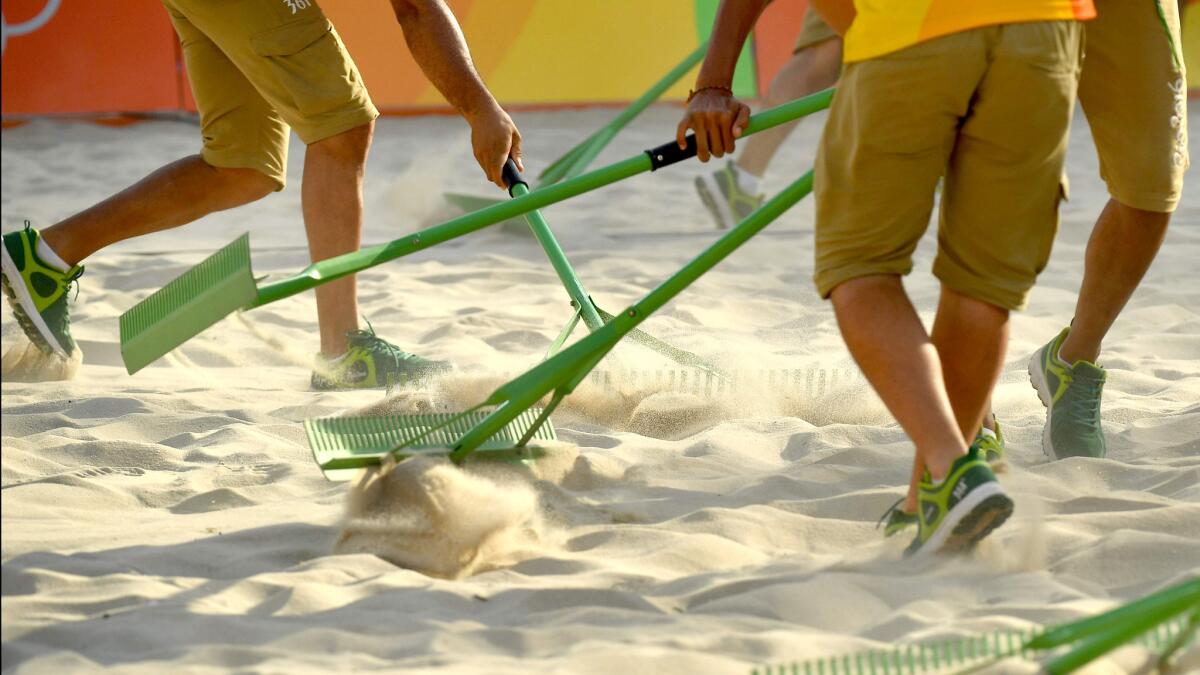Rakers are the unsung heroes of Olympic beach volleyball

At a break in the action, the six march to the sideline with rakes at the ready.
They pause, to be sure they’ll be in unison. Then they get to work.
Music is blasting, the crowd is cheering and the players are getting a breather. Meanwhile, the six have 25-30 seconds to go through their carefully choreographed steps to smooth the sand of what are now the most famous beach volleyball courts in the world.
They are the rakers of the Olympic beach volleyball tournament at Copacabana, and without their attention to detail, the world’s best beach volleyball players would not have an idyllic playing surface. That would mean exposure to injuries and make it tougher for officials to determine whether balls are in or out.
Three work each side of the net, each with a specific area to sweep. Two around the net, two by the base line and two in between. They can’t walk over areas they have swept, or else the job is ruined.
They are among many in Rio who ensure that the Olympic events go off without a hitch.
“I consider myself a lucky guy to be in an event like this, doing this job,” Valdeir Vieira, one of the rakers, said through an interpreter. “It’s an important thing we do to prepare the courts to avoid problems with the players and help the referees.”
There are 35 of them at the beach volleyball venue. All have had experience at smaller events around Brazil. Before the Olympics, they trained for a week with Olympic officials and sharpened their raking abilities in scrimmages before pool play.
Their responsibilities include more than just raking the sand on the main court. They also must manicure the four practice courts and help to clean the sand after each day, which involves digging the sand up to 50 centimeters deep and sifting it to make sure it is free of large particles.
“This preparation of the court is very important for the players,” said Fernando Marques, the competition manager for beach volleyball. “They think this is the most important thing regarding these preparations, to keep the area in the best condition for the players and for the others.”
They are also responsible for smoothing the sand along the lines, which makes it easier to see where a ball lands.
Replay challenges have helped ease the burden for the rakers, but it makes the match go smoother if referees can make the correct call without replay.
The rakers are more than just rakers. Vieira, 24, is studying information technology in college while another raker, Josue Souza, 18, is studying business administration.
They are close to the best volleyball players in the world, something both Vieira and Souza said was a privilege, but they are not there to ask for autographs. Their interaction is limited to asking players whether the sand is to their liking.
“As far as going underneath the net and getting it smoothed out — we mess it up pretty quickly — so we certainly appreciate what they do for us,” U.S. player Brooke Sweat said. “You step in a divot or a hole you’re not expecting to be there and it can throw off your timing or your approach.”
The rakers will come out a few times during a set. Once they are done grooming the sand, they meet at the opposite end of the net from where they started, like soldiers returning to formation. They pause for a moment, then they dart off to the sides, becoming invisible again until the next timeout or set break.
Most of time they go unnoticed, but that’s the way they like it.
Twitter @ChristopherHine
Go beyond the scoreboard
Get the latest on L.A.'s teams in the daily Sports Report newsletter.
You may occasionally receive promotional content from the Los Angeles Times.



